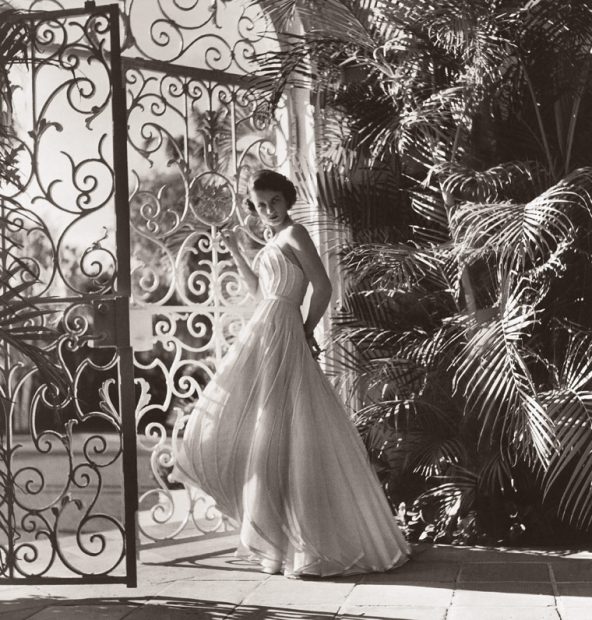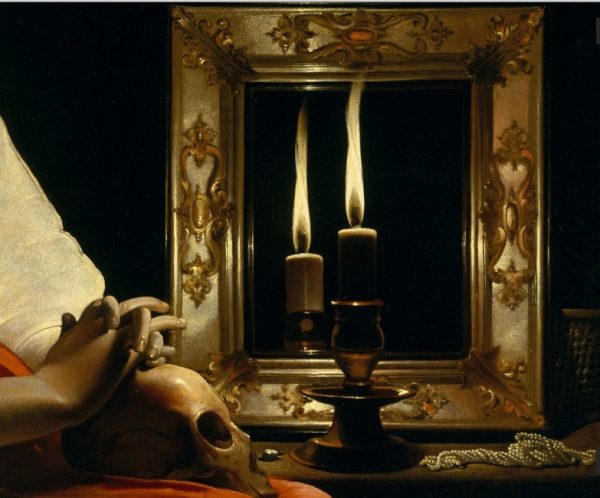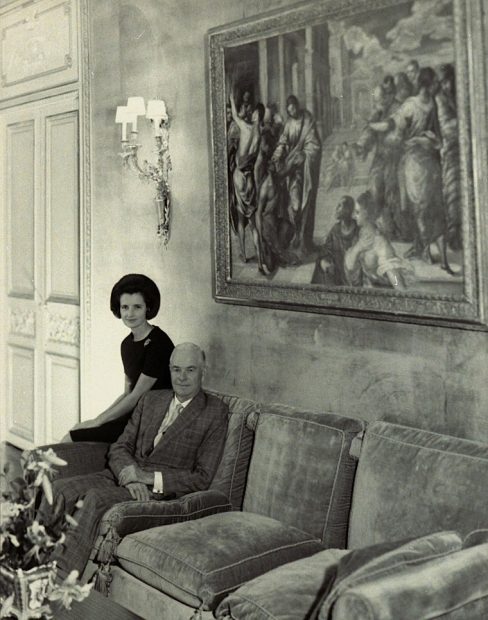
Mr. and Mrs. Wrightsman in their 820 Fifth Avenue apartment. They are seated beneath Christ Healing the Blind, an early El Greco, which they donated to the Met in 1978. Photo by Cecil Beaton, Vogue, October 1, 1966.
Texas oil money has never procured a collection of oil-on-canvas works nearly as magnificent as that of Charles (1895–1986) and Jayne (1919-2019) Wrightsman, who were the preeminent patrons of the Metropolitan Museum of Art during the last half-century. Their 1,275 gifts generously provided for several departments. The decorative arts galleries they established feature one of the best collections of French furniture and decorative arts in the world. Mrs. Wrightsman mentored First Lady Jacqueline Kennedy when she redecorated the White House in 1961-63. The Kennedys, in turn, gave the Wrightsmans entry into high society.
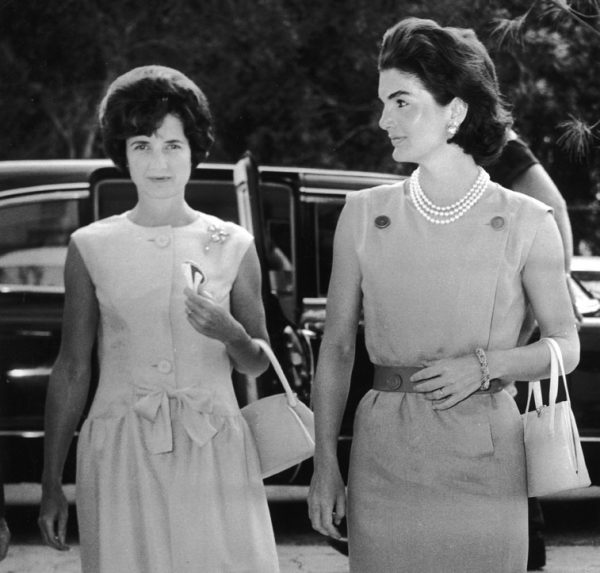
Mrs. Wrightsman and First Lady Jacqueline Kennedy enter the Biltmore Hotel, Palm Beach, March 1961. Photo by Bert Morgan.
This article highlights a few of the 94 works the Wrightsmans donated to the Department of European Paintings, including some from Mrs. Wrightsman’s bequest of 2019. Unless otherwise noted, quotes are from Charles and Jayne Wrightsman and the Metropolitan Museum of Art.
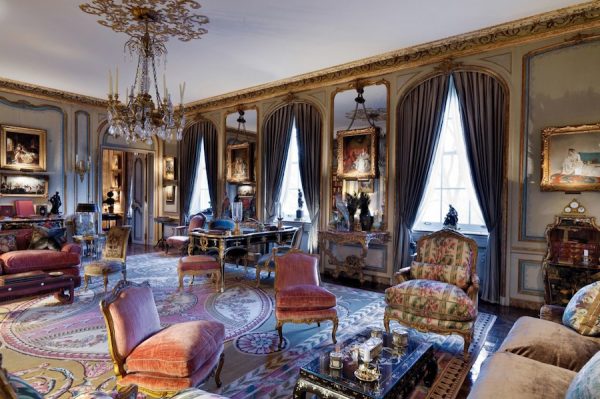
Inerior of Mrs. Wrightsman’s Fifth Avenue apartment, with paintings given to the Metropolitan in her bequest. Photo from Habitually Chic.
Wildcatter Charlie Makes his Fortune, Autodidact Jayne Becomes an Art Expert
Charles was born in Pawnee, Oklahoma in 1895, to a wildcatter father who made several fortunes in the oil business, only to lose them on the stock market. His father is credited with helping to devise the oil depletion allowance (the gift to the petroleum industry that keeps on giving, even when the gushers are running dry). Charles was educated at Phillips Exeter Academy, Stanford, and Columbia. Family history endowed him with faith in tangible commodities (like oil), and deep distrust of paper securities. Wrightsman moved to Fort Worth in 1918, and he developed oil properties in several states. Though he is sometimes described as a self-made man, in truth he took his inheritance prematurely: his father signed oil wells over to him when he was ill, and Charles declined to return them when his father recovered. In 1932 he became president of the Standard Oil Company of Kansas. He sold off its Kansas properties, and, according to the New York Times, “engaged solely in production at its Texas properties.” Court documents (discussed below) indicate, on the contrary, that the company had revenue-producing assets in ten states.
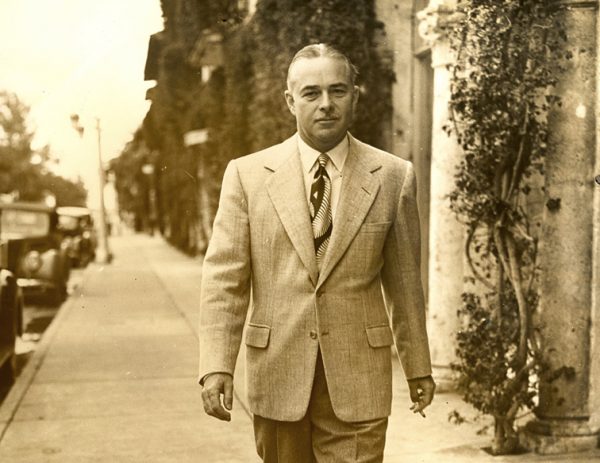
Charles B. Wrightsman, oilman and polo player on Worth Ave., Palm Springs, 1941. Photo by Bert Morgan.
A tough and canny businessman (the word “brutal” is sometimes used to characterize him), Wrightsman owned 93.7 percent of Standard Oil Company of Kansas when the company’s liquidation was concluded in 1951. He continued to operate the oil properties thereafter.
The Wrightsmans tried to deduct expenses connected to art collecting in 1960-61 as business expenses. See: Cases Decided in the United States Court of Claims, May 1, 1970 to July 31, 1970, vol. 192. These claims were denied in 1970 because the Wrightsmans were found to enjoy their art. The Wrightsman v. United States decision provides the information on Charles’ business practices and investments discussed here, as well as valuable insights regarding their art collecting practices. Charles was notoriously tight-lipped, and Jayne likewise refused interviews. An anecdote in Charles’ New York Times obituary provides the rationale for his secretiveness: “I had a father who told me, ‘I never saw a deaf and dumb man in jail.’”
Born Jane Kirkman Larkin in Flint, Michigan, the future Mrs. Wrightsman was raised in the Los Angeles area after her parents separated, where she added a “y” to her first name and began a remarkable process of self-invention. She worked in the glove department at Saks, as a film extra, as a swimsuit model, and at a perfume counter. It is not certain how Charles and Jayne met, but they married in 1944. In 1947 they bought a house in Palm Beach called Blythedunes. It was close to a Kennedy family property, though, according to a 1999 article in Connoisseur by Khol Nguyen, Joseph P. Kennedy considered Charles to be a “boorish Texan,” while the latter viewed the Kennedy patriarch as an “Irish crook.” The two families from opposite ends of the political spectrum became friendlier as John F. Kennedy made his political ascent. President Kennedy subsequently took therapeutic swims in the Wrightsman’s heated salt-water pool. Significant art collecting began in the 1950s, when the Wrightsmans changed the Blythedunes décor from English to French. (Donald J. Trump sold the property — with a different house — for $95 million in 2008 to Dmitry Rybolovlev, the seller of the $450 million “Leonardo.” This high price has sometimes been viewed as a Russian pay-off to Trump, funneled through an oligarch.) After Kennedy’s election, he and Jackie stayed with the Wrightsmans at Palm Beach, and he also invited them to important functions in Washington.
Forsaking polo and ponies, Charles set out to attain social status through art collecting. Jayne has been described as Charles’ Pygmalion. With the help of language and etiquette tutors and mentors that included designers, dealers, museum professionals, and scholars, she — by all accounts — became an extraordinarily knowledgeable collector. Charles had first visited the Met in 1949, and made his first gifts and loans in 1955. The following year, he was elected to the board of trustees (when he retired in 1975, Jayne joined the board). In 1962, the museum’s treasurer received this happy news in a letter from the Houston-based Charles B. Wrightsman Foundation: “It is now anticipated that Mr. Wrightsman’s collection of works of art will ultimately be given to the Museum.”
The Wrightsmans entertained lavishly — on yachts and on dry land — and they rubbed elbows with many of the people who seemed to matter most in high society. These interactions were lubricated by copious amounts of caviar and champagne, and by Charles’willingness to pick up tabs. A 1983 profile in Vanity Fair quotes a letter from Nancy Mitford to Evelyn Waugh that describes the couple: “Old Chourlie [sic] is the 7th richest man & about the 4th nastiest but I love him, he makes me scream with laughter.” Mitford characterized Jayne as “head girl of N.Y. charm school, not bad at all.”
John Pope-Hennessy, who was recruited by the Wrightsmans, became Consultative Chairman of the department of European paintings at the Metropolitan in 1977. He is credited with steering the Wrightsmans in the direction of paintings. Francis Watson, who advised the Wrightsmans and authored a multi-volume catalogue of their collection, observes that the top of the French decorative arts market had been exhausted by the mid-1970s. Watson, quoted in Nguyen’s Connoisseur profile, says Jayne had “bought the last of the best.” Charles’ health declined in 1983, and when he died in 1986, former director Thomas Hoving characterized him as “one of the most significant — and difficult — trustees in the history of The Metropolitan Museum of Art.” Hoving added: “in his quiet, devious way, he did more to upgrade the Met… than perhaps anyone else.” This is not a typical museum world encomium because Hoving — whom Charles tried to fire on more than one occasion — had a second career as a muckraking editor and author of confessional autobiographies. Though Charles’ lips remained sealed, Hoving (and others) disseminated negative information about the Wrightsmans in various publications. (Some are repeated in this New York Post article.)
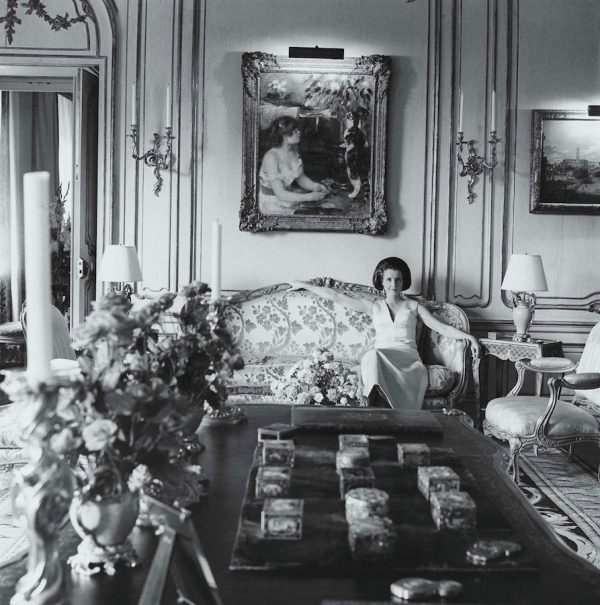
Jayne Wrightsman in her New York apartment, wearing a satin gown by Givenchy, sitting on a Louis XV cut-velvet sofa under Renoir’s Girl with Cat. An ebony Louis XV table signed b.v.r.b. (made for Mme de Pompadour and subsequently owned by the Duc de Richelieu) is in the foreground. It is topped with a collection of rare snuff-boxes. Photo by Cecil Beaton, 1966.
Jayne inherited Charles’ estate, estimated at about $150 million. Her gifts to the museum continued unabated.
Philippe de Montebello, Director Emeritus of the Metropolitan, emphasizes “just how learned and informed Jayne was about every aspect of art and the history that she knew so well.” The Vanity Fair profile cited above notes that banker and collector Jakob Rothschild ranked Mrs. Wrightsman with the estimable collectors Norton Simon and Paul Mellon, while J. Carter Brown, former director of the National Gallery of Art, declared: “I always championed her, because so few who have money also have the taste and the smarts. She really understands, and she really loves art.” John Walker, another National Gallery Director Emeritus, was one of Mrs. Wrightsman’s mentors. In an introduction to a Met catalogue of the Wrightsman collection, he declares: “Jayne has dedicated herself to the most intensive and successful self-education of any connoisseur I know.”
George Shackelford, Senior Deputy Director of the Kimbell Art Museum in Fort Worth, recalls in an email to the author that when he toured Mrs. Wrightsman through the galleries of Boston’s Museum of Fine Arts in the 1990s, “she was extraordinary in knowing what show this and that painting had been in, what related works were in which museums, who had written about this work or the other — in short, she was savvy and sophisticated. Not having met her before, I was distinctly impressed and also had a great time in her company.” Keith Christiansen, the John Pope-Hennessy Chairman of the Department of European Paintings at the Met, points out that the Wrightsman gifts to the department “can be measured by quality and depth” and “perhaps even more critically by their transformative impact.” He adds that in seven Old Master galleries, a Wrightsman painting “holds center stage.”
The Wrightsmans always wanted the best objects for the Metropolitan. Mrs. Wrightsman served on the critical Acquisitions Committee, which she chaired for many years. They made contributions for several major acquisitions, including Rembrandt’s Aristotle with Bust of Homer (1961), Velázquez’s Juan de Pareja (1971), Rubens’ A Forest at Dawn with Deer Hunt (1981), Batoni’s Diana and Cupid (1982), Hans Baldung Grien’s St. John on Patmos (1983), and Scheggia’s Triumph of Fame (1995). More often, the Wrightsmans acquired paintings in their entirety.
Highlights of the Wrightsman Old Masters
This personal selection includes some of the rarest and most important of the Wrightsman gifts. It follows the order in which they were donated. My commentaries draw on the Met website.
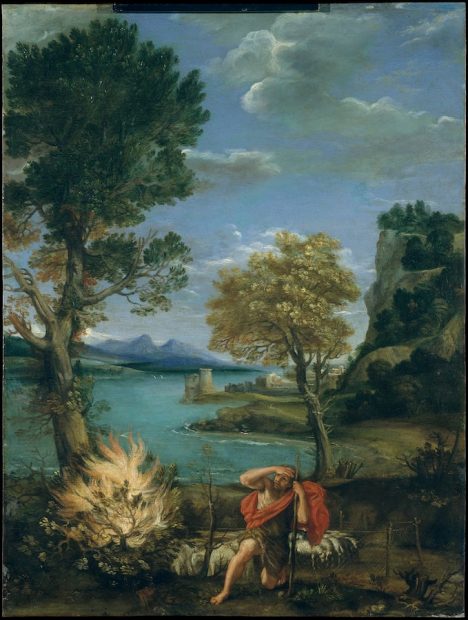
Domenichino (Domenico Zampieri) (Italian, Bologna 1581–1641 Naples), Landscape with Moses and the Burning Bush, c. 1610–16, oil on copper, 17 3/4 x 13 3/8 in. (45.1 x 34 cm), Gift of Mr. and Mrs. Charles Wrightsman, 1976.
This little gem is a personal favorite that holds its own in a gallery with several very large paintings. The burning bush was one of the three signs given to the shepherd Moses that confirmed his mandate to lead the Israelites out of Egypt. Fortunately, the artist chose a beautiful Italianate landscape rather than a barren Egyptian one, which is just as well, since there is no archaeological evidence for the Exodus. The dramatic spaciousness of Domenichino’s landscapes are recognized as precedents for those of Claude Lorrain (1600–1682). Few artists have packed as much space into a diminutive painting like this one.
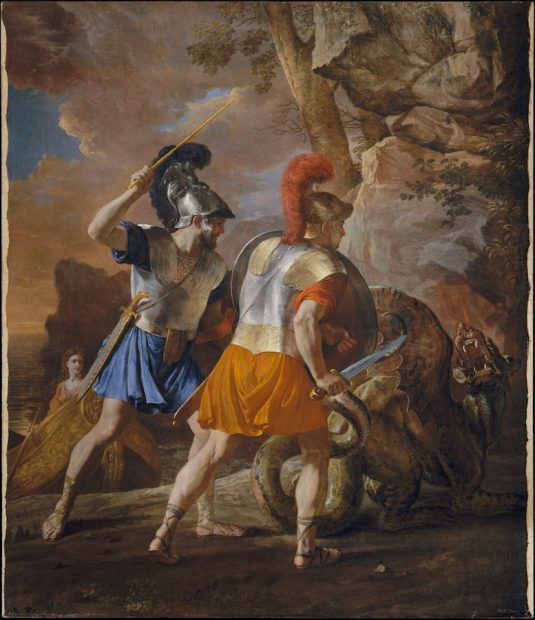
Nicolas Poussin (French, 1594–1665). The Companions of Rinaldo, c. 1633. Oil on canvas, 46 1/2 x 40 1/4 in. (118.1 x 102.2 cm). The Metropolitan Museum of Art, New York, Gift of Mr. and Mrs. Charles Wrightsman, 1977.
This is one of four extraordinary paintings Poussin made based on the poem Jerusalem Delivered (1580), an imaginative treatment of the First Crusade. Two knights — both wonderfully rendered in Roman-style armor — confront a magnificent dragon with sword and magic wand in hand. The beautiful, luminous color and the softly rendered naturalism of the setting are reasons why I generally prefer early Poussin to the late, severe Poussin.
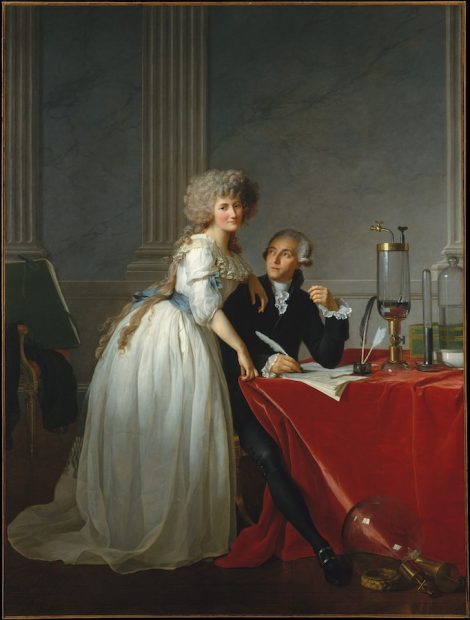
Jacques Louis David (French, 1748–1825). Antoine-Laurent Lavoisier (1743–1794) and His Wife (Marie-Anne-Pierrette Paulze, 1758–1836), 1788. Oil on canvas, 102 1/4 x 76 5/8 in. (259.7 x 194.6 cm). The Metropolitan Museum of Art, New York, Purchase, Mr. and Mrs. Charles Wrightsman Gift, in honor of Everett Fahy, 1977.
Arguably the most important of the Wrightsman paintings, this impressive double portrait is the focal point of the Met’s French Neoclassical gallery, a majority of whose paintings are Wrightsman gifts. Lavoisier founded modern chemistry and made many important discoveries. Unfortunately, he was also a fermier-général (tax collector), which is why he lost his head during the French Revolution. This painting blends ordered, carefully-staged theatricality with surprisingly naturalistic details.

Jacques Louis David, Antoine-Laurent Lavoisier (1743–1794) and His Wife (Marie-Anne-Pierrette Paulze, 1758–1836), detail of scientific instrument.
David’s powers of direct observation are particularly evident in his rendering of complex optical effects on glass.
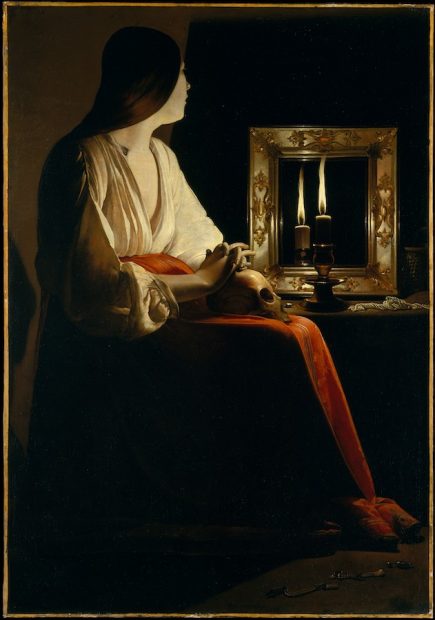
Georges de La Tour (French, 1593–1653). The Penitent Magdalen, c. 1640. Oil on canvas, 52 1/2 x 40 1/4 in. (133.4 x 102.2 cm). The Metropolitan Museum of Art, New York, Gift of Mr. and Mrs. Charles Wrightsman, 1978.
La Tour’s stark portrayal of the Magdalen captures the moment of conversion, when she discards her jewelry — seen on the table and the floor — and nestles a skull, which, along with the flame, symbolizes the brevity of life and her conversion from pleasure to meditative piety.
Still life objects carry the burden of meaning in this icon of quietism. Because the Magdalen is turning away from the world, we can scarcely see her face. And we, too, are compelled to meditate on light and dark.
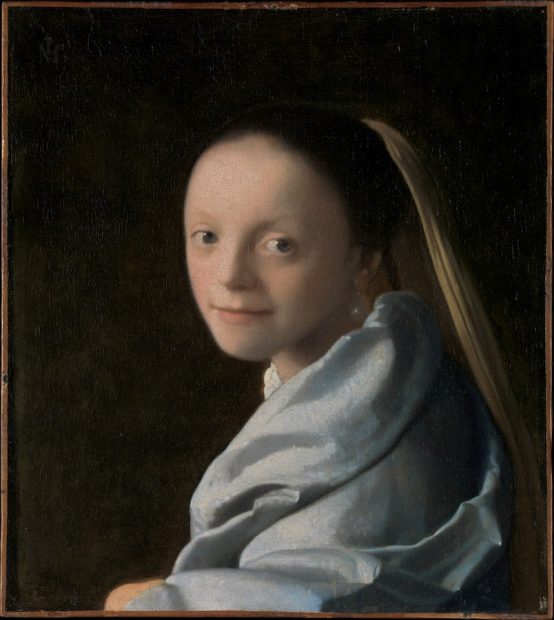
Johannes Vermeer (Dutch, 1632–1675). Study of a Young Woman, c. 1665–67. Oil on canvas, 17 1/2 x 15 3/4 in. (44.5 x 40 cm). The Metropolitan Museum of Art, New York, Gift of Mr. and Mrs. Charles Wrightsman, in memory of Theodore Rousseau Jr., 1979.
In the mid-1970s, I vowed to see every Vermeer, and I had the idle thought that it would be nice if this work would be given to the Met. This came to pass in 1979, capping an astonishing string of Wrightsman donations. Even with its cracked surface, this canvas radiates a mysterious allure. It’s hard to believe that a National Gallery donor passed on it in 1955, but their loss is the Met’s spectacular gain.
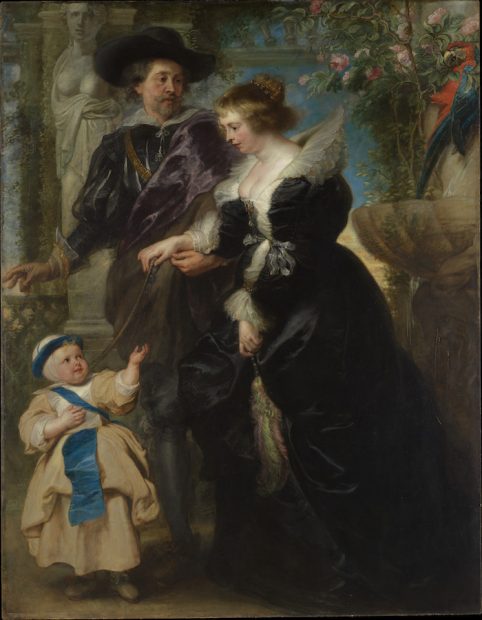
Peter Paul Rubens (Flemish, 1577–1640). Rubens, His Wife Helena Fourment (1614–1673), and Their Son Frans (1633–1678), c. 1635. Oil on wood, 80 1/4 x 62 1/4 in. (203.8 x 158.1 cm). The Metropolitan Museum of Art, New York, Gift of Mr. and Mrs. Charles Wrightsman, in honor of Sir John Pope-Hennessy, 1981.
Now the crowning glory of the Rubens gallery and arguably the finest Rubens in the U.S., this masterpiece was purchased after having been rejected by the Getty Museum and the Frick Collection (a granddaughter of museum founder Henry Clay Frick objected to the cleavage-revealing dress). Rubens depicts himself with his young wife (known as “the Helen of Flanders”) and a son, all decked out in lavish costumes in a setting based on his own magnificent garden. In those days, young boys wore dresses, “bumper hats,” and were led on leashes. Rubens celebrates his vision of domestic bliss in the full flower of his mature, painterly style. He brilliantly renders a wide range of materials: the reflective textures of dark silks contrast with white lace, vegetation, marble, feathers, and flesh.
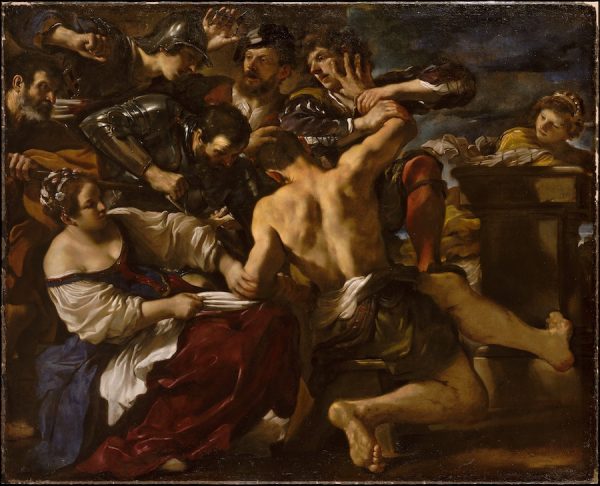
Guercino (Giovanni Francesco Barbieri) (Italian, 1591–1666). Samson Captured by the Philistines, 1619. Oil on canvas, 75 1/4 x 93 1/4 in. (191.1 x 236.9 cm). The Metropolitan Museum of Art, New York, Gift of Mr. and Mrs. Charles Wrightsman, 1984.
Purchased from a palace in war-ravaged Beirut, this Guercino was a key building block in the museum’s Italian Baroque collection, which was largely assembled in the last 40 years. Michael Fried, in his book After Caravaggio (2016), says this painting is “arguably the most profoundly conceived in Guercino’s entire oeuvre.” It will likely always be the museum’s best example of a large-scale Caravaggesque canvas with dramatic chiaroscuro and frenzied action. For good measure, the Wrightsmans also contributed a large classicizing painting by the same master, as well as other notable Italian Baroque paintings, including the Domenichino discussed above.
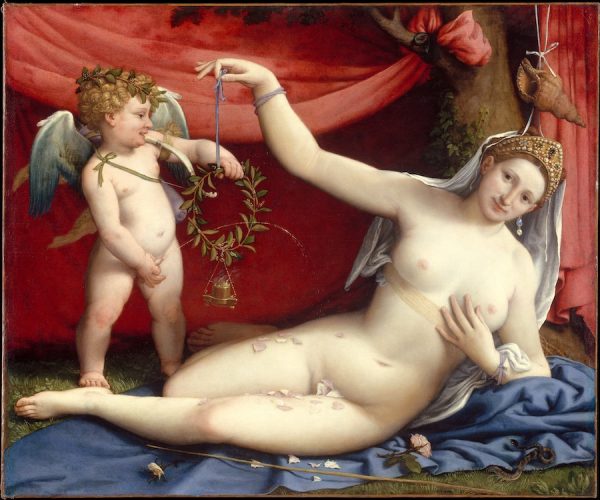
Lorenzo Lotto (Italian, ca. 1480–1556). Venus and Cupid. c. 1520s. Oil on canvas, 36 3/8 x 43 7/8 in. (92.4 x 111.4 cm). The Metropolitan Museum of Art, New York, Purchase, Mrs. Charles Wrightsman Gift, in honor of Marietta Tree, 1986.
Lotto is one of my favorite artists, and I am particularly fond of this painting. Christiansen, in his catalogue entry on the Met website, rightly refers to it as “one of the most individual masterpieces of Venetian painting.” It was Pope-Hennessy’s favorite Wrightsman picture. Everett Fahy, who retired as the John Pope-Hennessy Chairman of European Paintings in 2009, calls the Venus and Cupid “our most important acquisition since Velásquez’s Juan de Pareja in 1971” in a 2009 book dedicated to Philippe de Montebello’s directorship.
So it might seem surprising that both Mrs. Wrightsman and the Met originally passed on it. The $3 million price tag might have been less of an impediment than Wrightsman’s sense of propriety. A friend (quoted in Vanity Fair) referred to her as “almost Victorian in her prudery.” Fortunately, after the Getty also passed on it, Wrightsman assented to its purchase. Made to celebrate a marriage, the painting is filled with beneficent symbolism. Cupid urinates through the wreath to auger fertility. Christiansen believes the face of Venus is likely a portrait of the bride. In his Wrightsman obituary in The Art Newspaper, Christiansen says the painting’s “irony and elevated wit” that were revealed in his research aligned with the donor’s sensibilities.
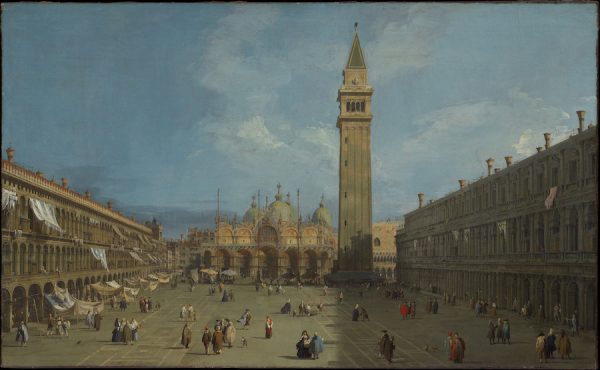
Canaletto (Giovanni Antonio Canal) (Italian, Venice 1697–1768 Venice). Piazza San Marco, c. late 1720s. Oil on canvas, 27 x 44 1/4 in. (68.6 x 112.4 cm). The Metropolitan Museum of Art, New York, Purchase, Mrs. Charles Wrightsman Gift, 1988.
Mrs. Wrightsman donated seven excellent Canalettos (the others came with her bequest in 2019). I choose this one because it is a quintessential subject, with the basilica of St. Mark and the Campanile. It was only the second work by Canaletto to enter the collection. The Wrightsmans also gave several Guardis and Tiepolos, and thus greatly strengthened the Italian Rococo collection.
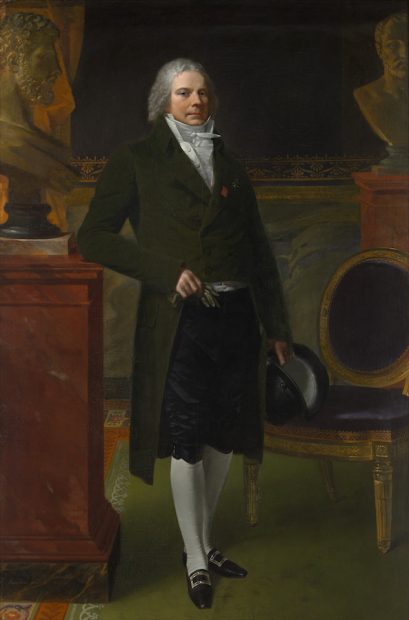
Pierre Paul Prud’hon (French, Cluny 1758–1823 Paris). Charles Maurice de Talleyrand Périgord (1754–1838), Prince de Talleyrand, 1817. Oil on canvas, 85 x 55 7/8 in. (215.9 x 141.9 cm). Purchase, Mrs. Charles Wrightsman Gift, in memory of Jacqueline Bouvier Kennedy Onassis, 1994.
On a cold winter’s day I entered a snooty New York gallery that admitted me with reluctance. I was dumbfounded to see this Prud’hon, with its beautiful, glowing colors. “This could hang with the Davids at the Met,” I exclaimed. Thanks to Mrs. Wrightsman, it hangs precisely in that exalted company, along with a full-length Prud’hon portrait of Talleyrand’s wife, and a commanding portrait of Talleyrand by François Gérard, which are among the other Wrightsman gifts that helped make the Met’s Neoclassical collection second only to that of the Louvre.
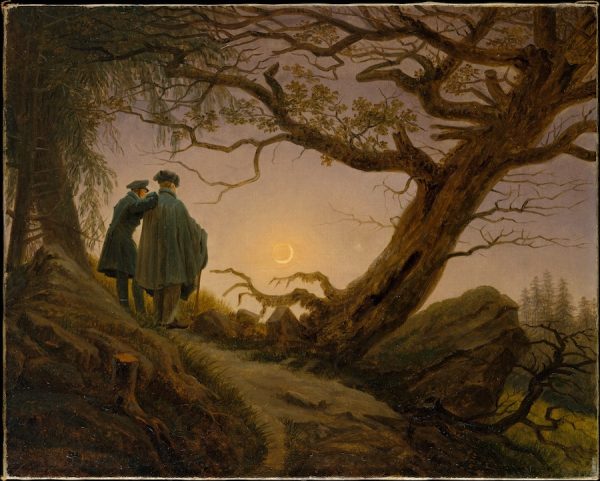
Caspar David Friedrich (German, Greifswald 1774–1840 Dresden). Two Men Contemplating the Moon, c. 1825-30. Oil on canvas, 13 3/4 x 17 1/4 in. (34.9 x 43.8 cm). The Metropolitan Museum of Art, New York, Wrightsman Fund, 2000.
Friedrich (right) depicts himself and his friend August Heinrich (1794–1822) as a pair of moon-struck Romantics partaking of the wonders of nature in the company of a de rigueur gnarled tree. The third iteration of a popular and much-admired composition, this is the best Friedrich in the U.S. It holds an important place in the Met’s galleries of Romantic era landscape paintings.
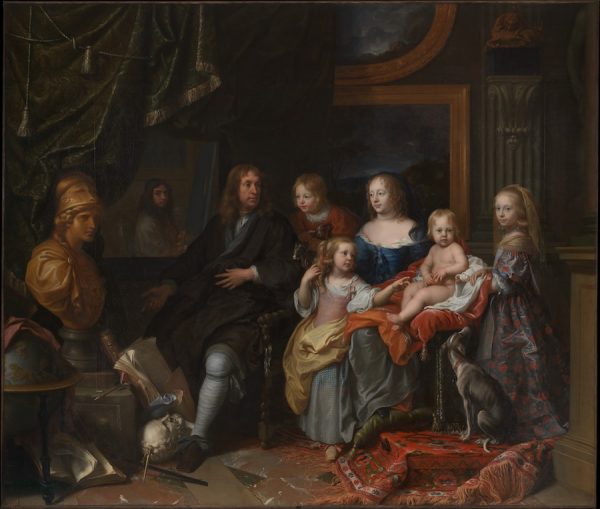
Charles Le Brun (French, 1619–1690). Everhard Jabach (1618–1695) and His Family, c. 1660. Oil on canvas, 110 1/4 x 129 1/8 in. (280 x 328 cm). The Metropolitan Museum of Art, New York, Purchase, Mrs. Charles Wrightsman Gift, 2014.
Le Brun was Louis XIV’s artistic director as well as his favored painter. Jabach’s best paintings and drawings are among the treasures of the Louvre. The Met has few examples of large, ambitious paintings by big name artists, so this is a most welcome addition to the collection. The big painting’s remarkable restoration at the Met is documented in a video. Christiansen calls it a “defining work of art and a key document in the cultural and political history of seventeenth-century France.” Be that as it may, I am perhaps a minority of one in judging it more important than good (but if curators in the U.K. had thought more highly of it, the painting would have been denied an export license). The sitters seem disjointed, Everhard Jabach’s portrait is not rendered particularly well, the golden bust of Minerva is positively lame, the artist’s reflection on the easel is underwhelming as well as spatially preposterous, and the setting is not convincingly depicted. Some elements are brilliantly done: the paper, the marble head on the floor, the inlaid floor itself, the carpet, and the girl’s dress. Did Le Brun’s ambition outstrip his painterly faculties, or was he wound too tight by his concentration on so many portraits?
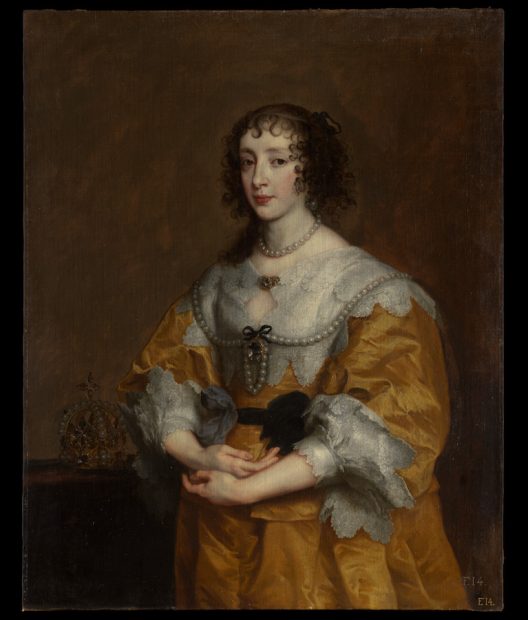
Anthony van Dyck (Flemish, Antwerp 1599–1641 London). Queen Henrietta Maria, 1636. Oil on canvas, 41 5/8 × 33 1/4 in. (105.7 × 84.5 cm). The Metropolitan Museum of Art, New York, Bequest of Mrs. Charles Wrightsman in honor of Annette de la Renta, 2019.
The daughter of French King Henry IV and Marie de’ Medici, Henrietta Maria was the queen consort of Charles I of England. She stands beside her crown, her “cradling” arms alluding to her pregnancy. Nicknamed “La Generalissima” for her militancy — Henrietta even pawned crown jewels to raise arms for the Catholic cause — this portrait was a gift for Francesco Barberini, a papal nephew and the Cardinal Protector of England and Scotland. Though somewhat understated for Van Dyck, it is a fully autograph royal portrait — a rarity for a master whose large workshop produced so many replicas. While this is not the “queen” of Van Dyck portraits in the Met, it is a worthy addition.
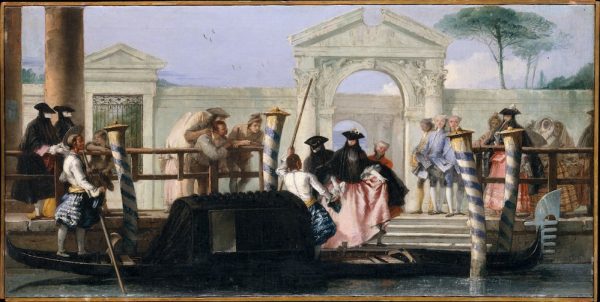
Giovanni Domenico Tiepolo (Italian, Venice 1727–1804 Venice). The Departure of the Gondola, c. mid-1760s. Oil on canvas, 14 1/8 × 28 3/4 in. (35.9 × 73 cm). The Metropolitan Museum of Art, New York, Bequest of Mrs. Charles Wrightsman, 2019.
Many have marveled at this stupendous painting, whose high quality and sylvan tones have sometimes led to an attribution to the artist’s father, Giovanni Battista. The suggestion has been made that this beautiful and mysterious painting was created in Madrid, under Giovanni Battista’s influence (see next image). This is one of the finest renderings of Carnival. It will be admired in the context of an extraordinarily large collection of paintings by the Tiepolos, a number of which were provided by the Wrightsmans.
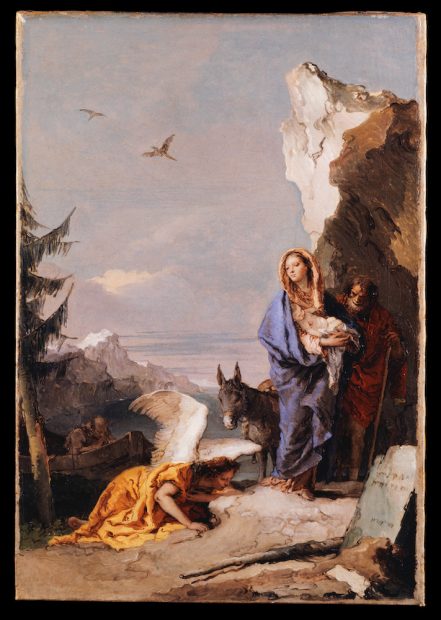
Giovanni Battista Tiepolo (Italian, Venice 1696–1770 Madrid). The Flight into Egypt, c. 1767-70. Oil on canvas, 23 5/8 × 16 1/4 in. (60 × 41.3 cm). The Metropolitan Museum of Art, New York, Bequest of Mrs. Charles Wrightsman, 2019.
The Flight to Egypt was one of the artist’s favorite motifs, and this is a fine example of the artist’s late style. Unlike some more obvious choices, such as the modello for the ceiling fresco at Würzburg (given by the Wrightsmans in 1977), it is readily legible in this format.

Jean François de Troy (French, Paris 1679–1752 Rome). The Garter, 1724. Oil on canvas, 25 1/2 × 21 1/8 in. (64.8 × 53.7 cm). The Metropolitan Museum of Art, New York, Bequest of Mrs. Charles Wrightsman, 2019.
In its day, the loosened garter depicted here was a provocative pretext to show a little lower leg. This painting might have been censored from an exhibition at the Place Dauphine in 1724 due to its subject matter. In the mid-twentieth century, it was still too risqué for the Kress Foundation (which also passed on the Wrightsman Vermeer). Perhaps the National Gallery should have tried to get a Mellon to buy this painting for them! Or maybe it was always destined to be a Wrightsman picture: it is just saucy enough, and filled to the brim with FFF (fine French furniture), including a gilt-bronze clock associated with André Charles Boulle.
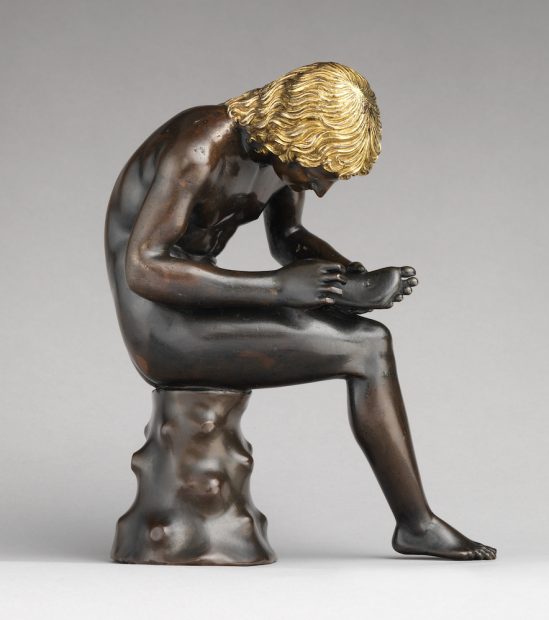
Antico (Pier Jacopo Alari Bonacolsi) (Italian, ca. 1460–1528). Spinario (Boy Pulling a Thorn from His Foot, probably modeled by 1496, cast c. 1501. Italian, Mantua. Bronze, partially gilt (hair) and silvered (eyes), H. 7 3/4 in. (19.7 cm), W. of base 2 15/16 in. (7.5 cm). The Metropolitan Museum of Art, New York, Gift of Mrs. Charles Wrightsman, 2012.
Less than eight percent of the Wrightsman gifts to the Met were paintings. As the sole representative of their benefactions in other fields, I choose this extraordinary Renaissance statuette, which James David Draper, Curator Emeritus of the Department of European Sculpture, calls “the Wrightsmans’ dearest sculptural possession.” Draper adds: “It is said to have accompanied the Wrightsmans on their travels, whereas I had always admired it on Mrs. Wrightsman’s bedside table.” Now we can understand why their chartered yachts were described as “floating Versailles” (Jayne was no doubt emulating the Roman emperors and Renaissance princes that traveled with select treasures), just as we can be grateful that objects like this marvel have disembarked for the last time and have come to rest at the Metropolitan.
Conclusion
The Metropolitan is celebrating its 150th anniversary this year, and its collections — which number a million and one-half objects — would no doubt stagger even its most optimistic founders. As A. Hyatt Mayor (1901–1980), the Met’s longtime curator of prints, noted in his 1969 Archives of American Art interview: “When the guards at the front door are asked, ‘Where is the art?’ they point up the main stairs to the painting galleries.” Paintings are the most prominent museum objects. How do the Wrightsman pictures compare with best Old Master collections previously gifted to the Met?
Henry Gurdon Marquand’s gifts of 1889, 1890 and 1891 provided the Met with a solid foundation, and helped to create a taste for Old Masters. Benjamin Altman’s bequest of 1913 made the Met’s collection credible in range and depth. Jules Bache’s collection (1949) has great strengths, but is a very mixed bag. The Robert Lehman Collection (1975) is astonishingly rich in early Renaissance paintings, and has significant works in many other areas. Of these collections, the Lehman easily has the greatest number of important paintings. If one were to choose the top 25 paintings in each collection, some art historians, depending upon taste, might prefer Altman’s, Bache’s, or Lehman’s over that of the Wrightsmans. But the Wrightsman paintings are highest in overall quality and condition. They collected expertise as well as art. Today’s experts are more knowledgeable and they possess more resources than those of past eras. Art is now much more accessible to curators and wealthy patrons, and valuable paintings are routinely subjected to a battery of scientific tests. By contrast, Altman chose many of his paintings from black and white reproductions. Bache was entirely dependent upon expert opinion, which was not always trustworthy. That is why he bought this preposterous fake Durer. The Wrightsmans also had another major advantage: they essentially served as an auxiliary purchase fund for objects the Met curators coveted, but could not afford. The National Gallery had earlier utilized the Wrightsmans as a buyer of last resort, but that institution lost out on their hoped-for patronage because it would not accept FFF as fine art.
In a letter of June 14, I912, the influential dealer and tastemaker Henry Duveen warned Altman (cited in the Altman article linked above) about works that were “only fit for French taste, being all of a class which we call ‘finicky’ and effeminate, so much sought after by French people.” The Wrightsmans, of course, had “French taste,” and they also bought works on the advice of curators that filled gaps in the collection, and thereby redressed the prejudices of previous generations.
Joseph H. Choate, corporate lawyer, wit, Met trustee, and future diplomat and statesman, gave a remarkable exhortation when the museum’s first building in Central Park opened in 1880:
“Think of it, ye millionaires of many markets — what glory may yet be yours, if you only listen to our advice, to convert pork into porcelain, grain and produce into priceless pottery, the rude ores of commerce into sculptured marble, and railroad shares and mining stocks — things which perish without the using, and which, in the next financial panic shall surely shrivel like parched scrolls — into the glorified canvas of the world’s masters… ours is the higher ambition to convert your useless gold into things of living beauty that shall be a joy to a whole people for a thousand years.”
(From Calvin Tompkins, Merchants & Masterpeices, 1970, rev. 1989)
One can hope that in the Met’s next 150 years, other millionaires will follow Choate’s sage advice as brilliantly as did the Wrightsmans.
****
The Met website provides copious information on the Wrightsman paintings, including: catalogue entries, provenance histories, bibliographies, and scholarly notes. It also has zoomable images.
****
When Ruben C. Cordova lived in New York, he split his time between the Met and his apartment.


